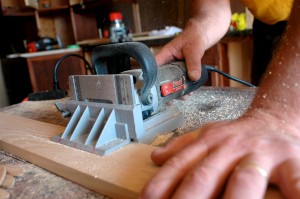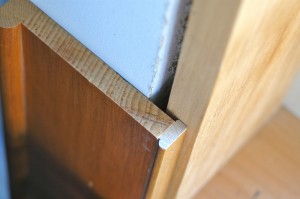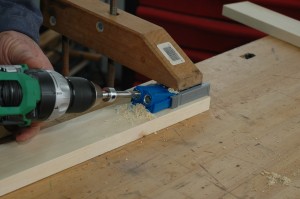Faster, neater window trim and molding installation with joints that never open up. These are the advantages of trim frames, and it’s an approach that’s easier and better than ever. I’ve never seen anyone else work like this but I know from experience that it’s super. Instead of custom-cutting pieces of wood individually before nailing them on the wall as pieces of window trim one by one, trim frames are cut and assembled ahead of time into three or four-sided frames, then mounted as one unit on the wall around the door or window you’re working on. This approach does require a completely different way of working, but the advantages are worth it in many situations. There’s no beating this kind of window trim approach for stain-grade work or any kind of composite trim designs with multiple moulding elements where filling gaps and mistakes isn’t possible.
Window Trim Challenges
Installing window trim and other mouldings presents several challenges no matter what your situation. The trim frame approach helps overcome the challenges that traditional, piece-by-piece trim installation involves. These include:
- Piece-by-piece installation is inherently inefficient because you’re always running back and forth between chopsaw and wall.
- The deck is also stacked against tight trim joints installed piece-by-piece because door and window casings typically aren’t flat. Any undulations or unevenness in the wall translates into open trim joints.
- When you do manage to get tight trim joints, there’s no guarantee they’ll stay that way because unconnected wood joints move seasonally.
Trim frames solve all of these problems while offering a special advantage for stain-grade work. When you can’t hide your sins under a layer of latex caulk, you’ve got no choice but to be good. Trim frame construction starts with a tape measure. Carefully measure the size of each door and window jamb you’re trimming, note the results, then add an allowance for a reveal along the inside edge of the jamb before making the frames to fit. The video below shows the details.
 In most cases the trim frame approach is only possible because of either biscuit joinery or pocket screw joinery. Biscuits are ovals of compressed, manufactured hardwood that fit into slots cut with a hand-held power tool. The result is an ultra-strong and hidden joint, but the way you use biscuit joints for trim frames depends on the kind of trim you’re working with. I use #20 biscuits for most trim frames, though the smaller #10 size is also useful.
In most cases the trim frame approach is only possible because of either biscuit joinery or pocket screw joinery. Biscuits are ovals of compressed, manufactured hardwood that fit into slots cut with a hand-held power tool. The result is an ultra-strong and hidden joint, but the way you use biscuit joints for trim frames depends on the kind of trim you’re working with. I use #20 biscuits for most trim frames, though the smaller #10 size is also useful.
You can also pre-join pieces of trim into frames with pocket screws. This is faster and neater than biscuits, but not as strong. It’s best to use biscuits when you need to transport or trim frames from your shop to a jobsite. If you’re making trim frames in the same building where they’ll be installed, then pocket screws are the way to go.
The easiest trim for making into frames is flat, wide casings that have no profile. This is the basis for traditional, extra-wide trim and moulding designs, with smaller trim and molding elements added afterwards piece-by-piece to enhance the look. Flat trim is thick enough that it’s easy to cut biscuit slots on the ends and edges of adjoining pieces of butt-joined trim. Cut the pieces of wood to length that you need for the top and sides, mill biscuit slots into adjoining ends and edges, then swab glue into the joints with a plumber’s flux brush before bringing parts together with biscuits and clamps. A sheet of plywood or particleboard on sawhorses makes a perfect jobsite workbench, and you only need to leave the joints clamped for 10 minutes before carefully taking the frame out, setting it aside to dry completely, then assembling another frame with the same clamps. Sand, stain and urethane your trim frames when they’re completely dry and before they go on the wall. Since door frames only have three sides, temporarily fasten a brace to the back of the trim frame at the bottom. You’ll remove it just before installation on the wall.
Since trim frame joints are held together securely at corners, you don’t need nearly as many fasteners to secure a trim frame to the wall. A few 2-inch long, 23-gauge pins every foot or so holds the frame nicely. If you want to use even fewer fasteners, daub construction adhesive on the back of the trim frame before it goes down. The pins just hold the frames temporarily while the adhesive dries. The results are great.
 Trim with moulded profiles is more challenging to join into a frame with biscuits ahead of time because you don’t have the chance to sand exposed surfaces flat and level after assembly. Depending on the complexity of the profile you’re working with, and how accurately you find your biscuit joinery turns out, you may want to try plunged biscuits. Assemble the mitre joints with glue, aligning the surface profile perfectly. Let the glue dry completely, flip the trim frame over gently, then plunge biscuit slots in from behind, making sure they don’t come out the front. Swab glue in the slots, add biscuits, then trim off the excess biscuits after the glue is dry. Plunged biscuit joinery isn’t nearly as fast because you need to wait for glue to dry, but it is a lifesaving technique when all else fails.
Trim with moulded profiles is more challenging to join into a frame with biscuits ahead of time because you don’t have the chance to sand exposed surfaces flat and level after assembly. Depending on the complexity of the profile you’re working with, and how accurately you find your biscuit joinery turns out, you may want to try plunged biscuits. Assemble the mitre joints with glue, aligning the surface profile perfectly. Let the glue dry completely, flip the trim frame over gently, then plunge biscuit slots in from behind, making sure they don’t come out the front. Swab glue in the slots, add biscuits, then trim off the excess biscuits after the glue is dry. Plunged biscuit joinery isn’t nearly as fast because you need to wait for glue to dry, but it is a lifesaving technique when all else fails.
The further along you progress on a building project, the slower and more finicky the work gets. At least this is true if you’re aiming for quality. Window trim and moulding installation proves it for sure. You might start off as a lean, mean framing machine as you’re building walls, but eventually you’ve got to pretend you’re a cabinetmaker. Putting up trim demands that you get pretty close to that challenge. Joints need to be tight, especially if you’ve got the added challenge of not being able to use filler because the trim is stained and won’t be painted later. All things considered, in my experience trim frames can certainly make you better than you might otherwise be. It’s faster, simpler and completely prevents window trim joints opening up over time. Continue reading below for more information and specific tips that’ll help you be more successful with the trim frame approach.
Window Trim Tip#1: Humbling Proud Drywall
 It’s not unusual for drywall to stick out proud of the interior edges of door and window jambs, and even a little bit of this nonsense is a big problem because it stops trim from contacting the jamb tightly. The traditional fix involves the nasty proposition of using a Surform plane to work the excess drywall back, but this is too messy, slow and inaccurate for anything more than occasional situations. An alternative is to install the main part of the trim on the existing drywall as a frame, but back a little further from the edges of the jamb than usual. This extra space allows room for an inner run of small bullnose trim or beading that can extend down to touch the edge of the jamb, spanning the gap caused by a jamb that doesn’t extend far enough. This is a lot faster than the Surform and looks terrific, too.
It’s not unusual for drywall to stick out proud of the interior edges of door and window jambs, and even a little bit of this nonsense is a big problem because it stops trim from contacting the jamb tightly. The traditional fix involves the nasty proposition of using a Surform plane to work the excess drywall back, but this is too messy, slow and inaccurate for anything more than occasional situations. An alternative is to install the main part of the trim on the existing drywall as a frame, but back a little further from the edges of the jamb than usual. This extra space allows room for an inner run of small bullnose trim or beading that can extend down to touch the edge of the jamb, spanning the gap caused by a jamb that doesn’t extend far enough. This is a lot faster than the Surform and looks terrific, too.
Window Trim Tip #2: When Trim Frames Won’t Work
Trim frames depend on square window and door frames, and prehung doors and modern windows almost always deliver the kind of accuracy required. But just to be sure, check your doors and windows with a 24” carpenters square before you build frames. You may need to enlarge the inside measurements of your trim frames a bit to allow for a small out-of-square condition.
Window Trim Tip#3: Pocket Screws for Thicker Stock
 Biscuits are great for joining trim frames, but pocket screws are faster when you can use them. Trim thickness and shape are deciding factors. If you’re dealing with wood that’s at least 5/8”-thick and flat, pocket screws are the way to go. Parts for fireplace mantels, box newels, built-in cabinets and bars are all applications where pocket screws shine. The fastest approach uses a stationary machine for drilling the required angled pocket screw holes, but a simple jig like the one shown here works great, too.
Biscuits are great for joining trim frames, but pocket screws are faster when you can use them. Trim thickness and shape are deciding factors. If you’re dealing with wood that’s at least 5/8”-thick and flat, pocket screws are the way to go. Parts for fireplace mantels, box newels, built-in cabinets and bars are all applications where pocket screws shine. The fastest approach uses a stationary machine for drilling the required angled pocket screw holes, but a simple jig like the one shown here works great, too.
Window Trim Tip #4: Toasting Biscuits
A snug fit within slots is one reason biscuit joints are so strong, but sometimes humidity can swell biscuits so they’re too tight to go into their slots. Twenty minutes in a toaster oven at 300ºF dries out the wood and shrinks the biscuits so they slip right in. The difference is amazing and well worth the little effort it takes.